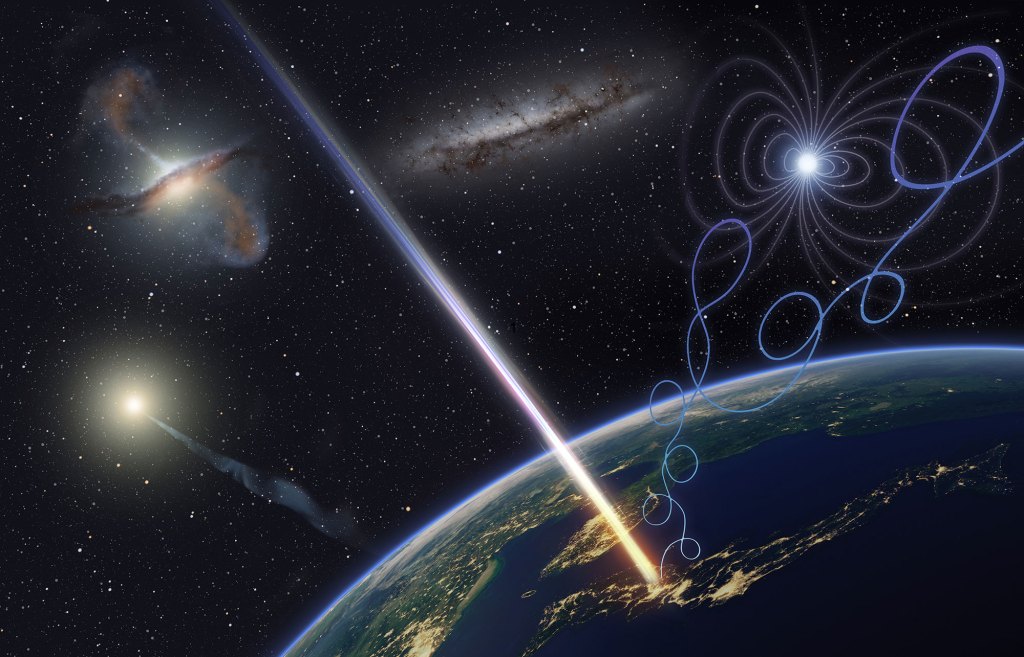A cosmic ray so powerful that scientists had to check their measurements to make sure it was real has collided with Earth. Now, experts are trying to determine its source, with no clear answers in sight.
It’s the second-highest-energy cosmic ray ever recorded, at 240 exa-electron volts (Eev), second only to the aptly-named “Oh-My-God particle” discovered in 1991, which clocked in at 320Eev. Researchers describe the amount of energy as the equivalent to dropping a brick on your toe from waist height.
Videos by VICE
Scientists detected the ray using the Telescope Array—a grid of more than 500 detectors spread across 700 square kilometers near Delta, Utah—in May 2021 and reported the finding last week in the journal Science. Dubbed the Amaterasu particle, after the Japanese sun goddess, the cosmic ray has puzzled scientists since it seemed to stem from an empty part of space. But if they could understand the mysteries of this and other ultra-high-energy cosmic rays, it could mean better understanding our universe and potentially unlocking new avenues in physics.
Cosmic rays are actually single particles, smaller than the size of an atom, zooming through space. When they hit the Earth’s atmosphere, they blast apart nitrogen and oxygen gas to create a shower of secondary particles, which detectors can pick up.
Cosmic rays with the energy of the Amaterasu or Oh-My-god particles are extremely rare (just over 60 have ever been detected). Other, much lower energy, cosmic rays bombard the Earth every second and often come from the Sun.
Creating these particles takes enormous power, explained study co-author John Matthews in an interview with Motherboard. The source needs to be strong enough to rip ordinary matter apart into subatomic parts and hurl them through the universe at near the speed of light.
“You need something with humongous electric fields and humongous magnetic fields and it’s got to be really, really big. The number of objects that can do that, as far as the theory goes, is pretty small,” Matthews, who is a physics and astronomy professor at the University of Utah, said.
Physicists have theorized that ultra-high-energy cosmic rays might come from supermassive black holes that swirl around superhot material, or a galaxy that’s creating stars at a phenomenal rate. But no one, not even the scientists behind this most recent discovery, have so far been able to find direct evidence of what makes these cosmic rays.
“They seem to come from random directions. There’s nothing special out there. That’s the big mystery,” Matthews said.
Matthews and the international team of researchers used the timing and energy of particles hitting the Telescope Array to trace Amaterasu’s trajectory. They’re able to map this out because, unlike lower energy rays that travel in a zigzag pattern, ultra-high-energy cosmic rays travel pretty much in a straight line.
It landed them in an area called the Local Void, so named because it’s mostly devoid of galaxies and supernovae. It’s also not clustered with any other ultra-high-energy cosmic rays the Telescope Array has found. The best theory researchers currently have is that the Amaterasu particle came from some unidentified source in the Local Void.
Alternatively, it could be that the was bent off course and came from somewhere else. That would mean that the particle is heavier than researchers estimate. “We haven’t had enough particles at really high energies to measure their composition,” Matthews said.
Even more tantalizing is the idea that these ultra-high-energy cosmic rays are made by some yet-undiscovered process of physics. “It could be new physics,” Bellido Caceres, who worked on a similar observatory called the Pierre Auger Observatory in Argentina, told Nature News.
“I’m not inclined to believe that,” said Matthews. “I’d rather find a big, violent object.”
Studying these immensely powerful rays—that have more than a million times more energy than particle accelerators here on Earth can produce—could unlock new avenues in physics and understanding our universe.
But it’s slow progress, said Matthews, who has been studying cosmic rays with the University of Utah since the mid-90s. “There’s a lot you can learn by piecing together all these things. It’s long and slow work.”
Nonetheless, Matthews said huge progress has been made since the Oh-My-God particle was recorded. He’s confident that they’ll know more in the next few years, particularly if the planned-expansion of the Telescope Array stays on track.
“If we have a few more years more data, now you’re starting to have enough of a sample across the whole sky that hopefully it either points back to stuff that you can explain or, if it doesn’t, then you’ve got a whole new puzzle you better start thinking about.”




